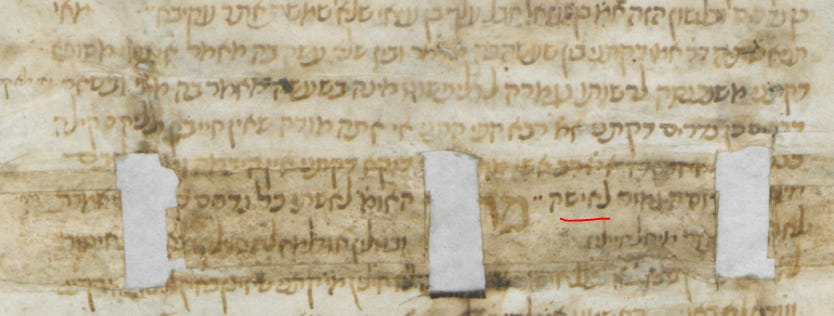Husband vs. Levir
As I was preparing for my daf yomi shiur today on Nedarim 75a, I noticed the following line, proving like Rav Ami that the case under discussion was where the yavam had performed maamar, a kind of betrothal, on the yevama (though had note yet consummated the relationship by performing yibum) :
אָמַר רַב אָשֵׁי, מַתְנִיתִין נָמֵי דַּיְקָא: אֵין יְבָמָה גְּמוּרָה לְאִישָׁהּ כְּשֵׁם שֶׁאֲרוּסָה גְּמוּרָה לְאִישָׁהּ.
Rav Ashi said: The mishna (74a) is also precisely formulated to indicate this, as it teaches: A yevama is not her husband’s full-fledged wife in the same manner that a betrothed woman is her husband’s full-fledged wife.
This seemed strange, for what was this diyuk from the Mishnah’s language? It didn’t seem to accord with the text of the Mishnah of 74a, which read:
אָמַר לוֹ רַבִּי יְהוֹשֻׁעַ: עֲקִיבָא, דְּבָרֶיךָ בִּשְׁנֵי יְבָמִין, מָה אַתָּה מֵשִׁיב עַל יָבָם אֶחָד? אָמַר לוֹ: אֵין הַיְּבָמָה גְּמוּרָה לַיָּבָם כְּשֵׁם שֶׁהָאֲרוּסָה גְּמוּרָה לְאִישָׁהּ.
Rabbi Yehoshua said to him: Akiva, your statement applies in a situation with two yevamin, but how do you reply to Rabbi Eliezer in the case of one yavam? Rabbi Akiva said to him: A yevama is not the full-fledged wife of the yavam in the in the way that a betrothed woman is her husband’s full-fledged wife, and the yavam is not empowered to nullify vows at all.
That is, Rav Ashi’s version had לְאִישָׁהּ, to her husband, in both the first and second clause, and made that diyuk, that both of them were quasi-equivalent, via betrothal (kiddushin) or maamar. But in our Mishnah, it was לַיָּבָם in the first clause.
My first thought was to check our Mishnah’s text. One easy way is to see how the commentators cite it ad loc. So, for instance, “Rashi” (really, the scholars of Mainz) has the following:
א"ל אין היבמה גמורה לאישה - שאם בא עליה זר אין נסקל שאין בה לא דין ארוסה ולא דין אשת איש ואין חייבין עליה אלא לאו דלא תהיה אשת המת וגו' (דברים כ״ה:ה׳):
And on Rav Ashi’s statement, explains it consistent with that.
Others, like Chasam Sofer and the Rosh, quote is as לַיָּבָם. Finally, the Ran doesn’t quote that part of the Mishnah, but doesn’t express surprise later at Rav Ashi’s statement. (We can also argue about what the diyuk is supposed to prove, and that can play into it.) Our printed Rif as well, w
Meanwhile the Kaufmann Mishnah manuscript has לאישה.
So too, the Mishnah in the Yerushalmi, 10:6:
משנה: אָמַר רִבִּי אֱלִיעֶזֶר. מָה אִם אִשָּׁה שֶׁקָּנָה הוּא לְעַצְמוֹ הֲרֵי הוּא מֵיפֵר נְדָרֶיהָ אִשָּׁה שֶׁקָּנוּ לוֹ מִן שָׁמַיִם אֵינוֹ דִין שֶׁיָּפֵר נְדָרֵיהָ. אָמַר לוֹ רִבִּי עֲקִיבָה לֹא. אִם אָֽמְרָת בְּאִשָּׂה שֶׁקָּנָה הוּא לְעַצְמוֹ שֶׁאֵין לָאֲחֵרִים רְשׁוּת בָּהּ תֹּאמַר בְּאִשָּׁה שֶׁקָּנוּ לוֹ מִן שָׁמַיִם שֶׁיֵּשׁ לָאֲחֵרִים רְשׁוּת בָּהּ. אָמַר לוֹ רִבִּי יְהוֹשֻׁעַ. עֲקִיבָה דְּבָרֶיךָ בִשְׁנֵי יְבָמִין מָה אַתָּה מֵשִׁיב עַל יָבָם אֶחָד. אָמַר לוֹ אֵין הַיְּבָמָה גְמוּרָה לְאִישָׁהּ כְּשֵׁם שֶׁהָאֲרוּסָה גְּמוּרָה לְבַעֲלָהּ.
That doesn’t have the local pull of Rav Ashi’s statement to make it conform.
Examining printings and manuscripts at Hachi Garsinan, both Vilna and the earlier Venice printing have ליבם. Here is Venice:
So does Vatican 110:
and Marburg: Hr. 15.32, 34, 40 Mishnah has:
and Parma, AS: Fr. ebr. 11:
However, Munich 95 indeed has לאישה:
What about on 75a, Rav Ashi’s diyuk? Both printings have לאישה. Munich 95 is consistent and has לאישה.
Vatican is inconsistent and has לאישה, misspelled:
AIU: H 3202 D.[ב] has לאישה, but also has שהאשה instead of arusa:
Finally, I found this one quite interesting, Madrid, CSIC: MS CVI - M / 106:
It is hard to make out the fragment, but it was encoded as:
You can decide if that matches what is there - there seems some more at the line start, but if so, here is a Rav Ashi diyuk that seems to mention ליבם, just like our printed Mishnah!
At the end of the day, I’d guess that לאישה is original, and it was intended figuratively, and was then hypercorrected in some manuscripts to ליבם, even though it messes up Rav Ashi’s diyuk. And I find the Yerushalmi’s Mishnah most persuasive there.














